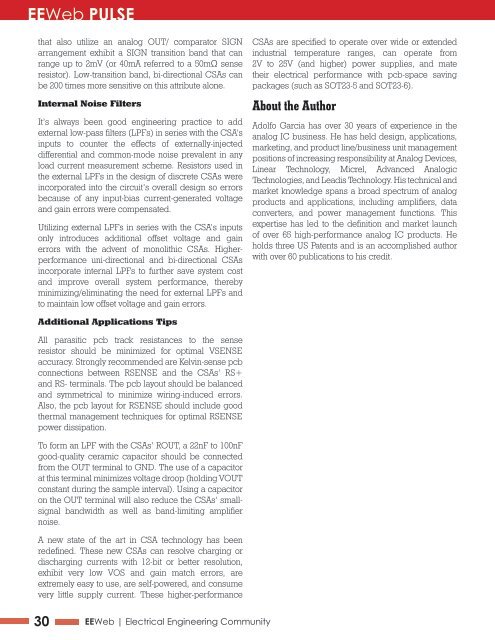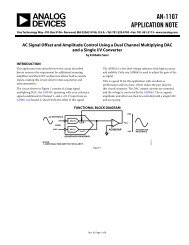Sailesh Chittipeddi - EEWeb
Sailesh Chittipeddi - EEWeb
Sailesh Chittipeddi - EEWeb
You also want an ePaper? Increase the reach of your titles
YUMPU automatically turns print PDFs into web optimized ePapers that Google loves.
<strong>EEWeb</strong> PULSE<br />
that also utilize an analog OUT/ comparator SIGN<br />
arrangement exhibit a SIGN transition band that can<br />
range up to 2mV (or 40mA referred to a 50mΩ sense<br />
resistor). Low-transition band, bi-directional CSAs can<br />
be 200 times more sensitive on this attribute alone.<br />
Internal Noise Filters<br />
It’s always been good engineering practice to add<br />
external low-pass filters (LPFs) in series with the CSA’s<br />
inputs to counter the effects of externally-injected<br />
differential and common-mode noise prevalent in any<br />
load current measurement scheme. Resistors used in<br />
the external LPFs in the design of discrete CSAs were<br />
incorporated into the circuit’s overall design so errors<br />
because of any input-bias current-generated voltage<br />
and gain errors were compensated.<br />
Utilizing external LPFs in series with the CSA’s inputs<br />
only introduces additional offset voltage and gain<br />
errors with the advent of monolithic CSAs. Higherperformance<br />
uni-directional and bi-directional CSAs<br />
incorporate internal LPFs to further save system cost<br />
and improve overall system performance, thereby<br />
minimizing/eliminating the need for external LPFs and<br />
to maintain low offset voltage and gain errors.<br />
Additional Applications Tips<br />
All parasitic pcb track resistances to the sense<br />
resistor should be minimized for optimal VSENSE<br />
accuracy. Strongly recommended are Kelvin-sense pcb<br />
connections between RSENSE and the CSAs’ RS+<br />
and RS- terminals. The pcb layout should be balanced<br />
and symmetrical to minimize wiring-induced errors.<br />
Also, the pcb layout for RSENSE should include good<br />
thermal management techniques for optimal RSENSE<br />
power dissipation.<br />
To form an LPF with the CSAs’ ROUT, a 22nF to 100nF<br />
good-quality ceramic capacitor should be connected<br />
from the OUT terminal to GND. The use of a capacitor<br />
at this terminal minimizes voltage droop (holding VOUT<br />
constant during the sample interval). Using a capacitor<br />
on the OUT terminal will also reduce the CSAs’ smallsignal<br />
bandwidth as well as band-limiting amplifier<br />
noise.<br />
A new state of the art in CSA technology has been<br />
redefined. These new CSAs can resolve charging or<br />
discharging currents with 12-bit or better resolution,<br />
exhibit very low VOS and gain match errors, are<br />
extremely easy to use, are self-powered, and consume<br />
very little supply current. These higher-performance<br />
30 <strong>EEWeb</strong> | Electrical Engineering Community<br />
CSAs are specified to operate over wide or extended<br />
industrial temperature ranges, can operate from<br />
2V to 25V (and higher) power supplies, and mate<br />
their electrical performance with pcb-space saving<br />
packages (such as SOT23-5 and SOT23-6).<br />
About the Author<br />
Adolfo Garcia has over 30 years of experience in the<br />
analog IC business. He has held design, applications,<br />
marketing, and product line/business unit management<br />
positions of increasing responsibility at Analog Devices,<br />
Linear Technology, Micrel, Advanced Analogic<br />
Technologies, and Leadis Technology. His technical and<br />
market knowledge spans a broad spectrum of analog<br />
products and applications, including amplifiers, data<br />
converters, and power management functions. This<br />
expertise has led to the definition and market launch<br />
of over 65 high-performance analog IC products. He<br />
holds three US Patents and is an accomplished author<br />
with over 60 publications to his credit.















